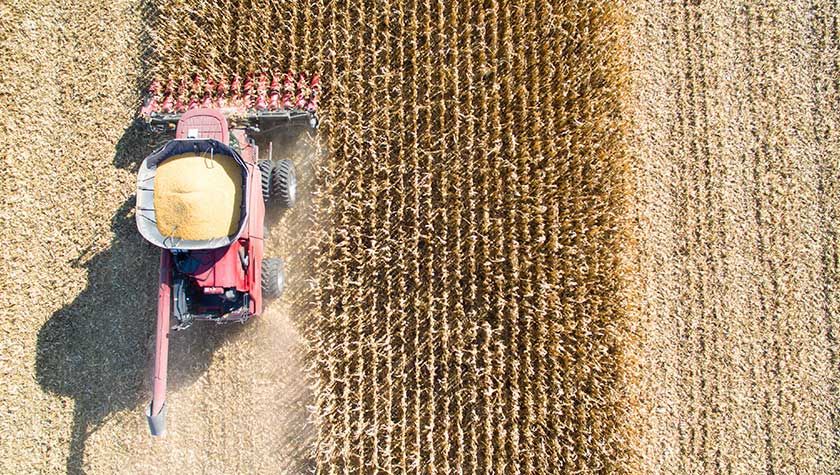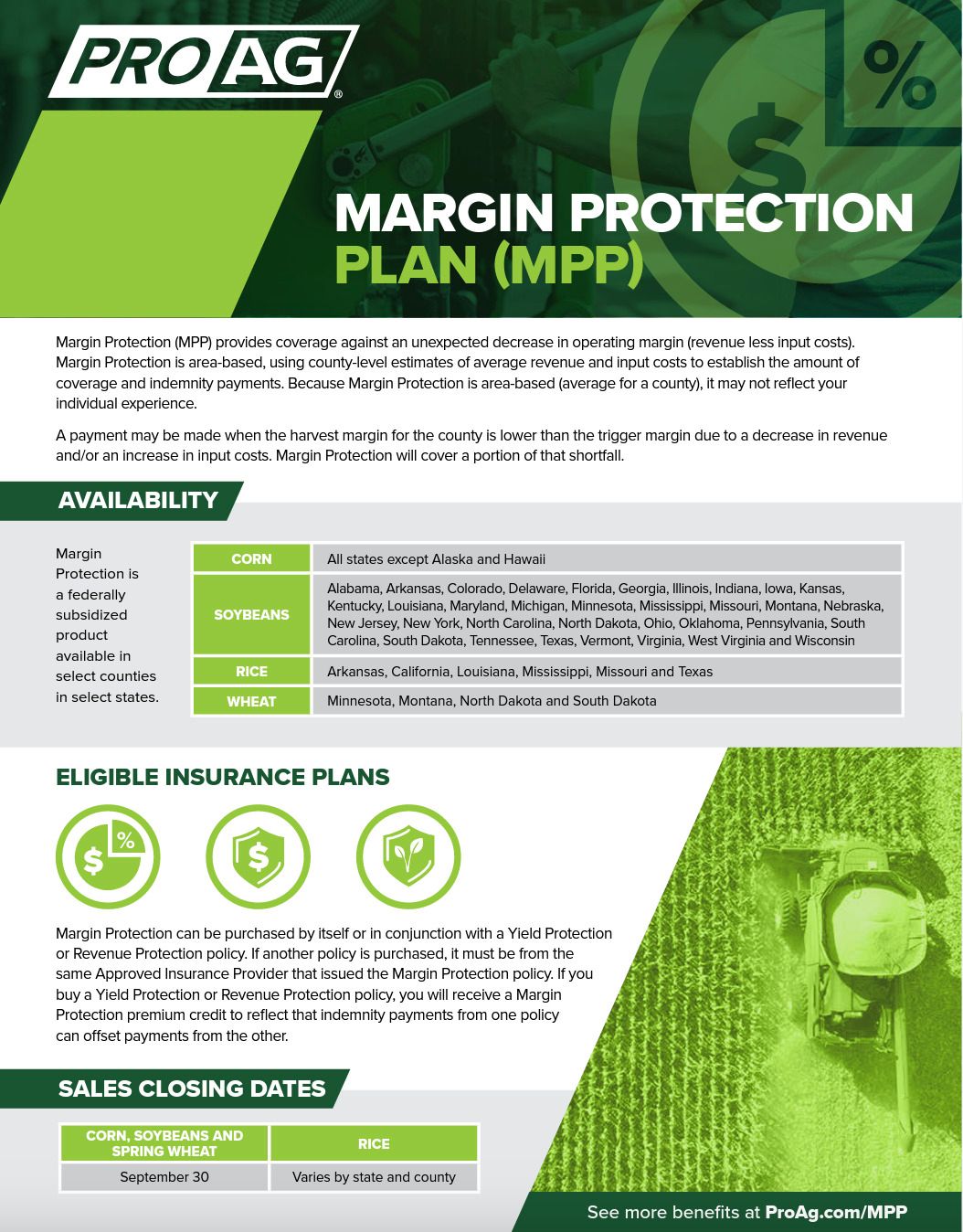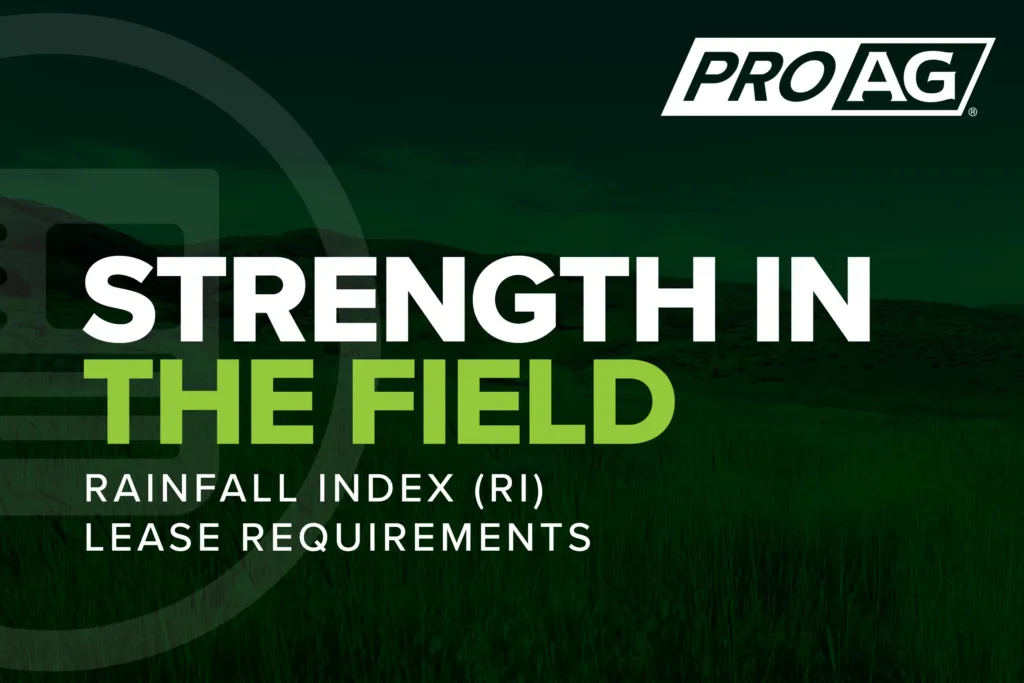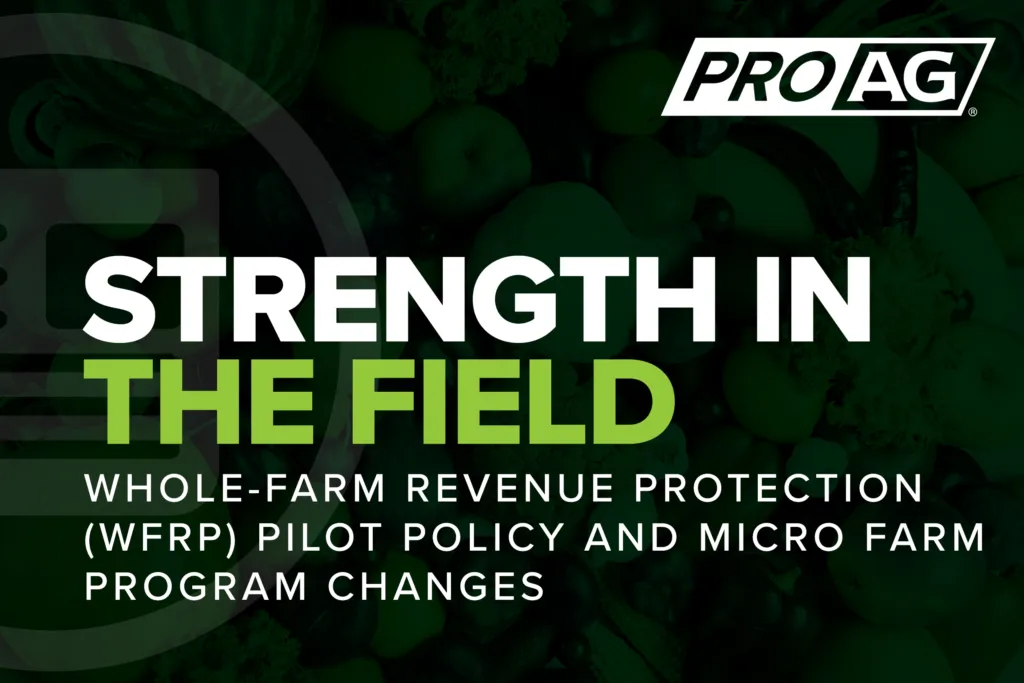Margin Protection Crop Insurance Plan (MPP insurance) provides coverage against an unexpected decrease in operating margin (revenue less input costs).
Margin Protection is area-based, using county-level estimates of average revenue and input costs to establish the amount of coverage and indemnity payments. Because Margin Protection is area-based (average for a county), it may not reflect your individual experience. Margin Protection insurance, first implemented in 2016 crop year, protects against decreases in margin caused by reduced county yields, reduced commodity prices, increased price of certain inputs or any combination of these issues.

How MPP Works
Margin Protection takes into considerations changes in crop prices, reductions of yields and changes in the prices of inputs used to grow the crop. A payment may be made on the Margin Protection insurance policy when the harvest margin for the county is lower than the trigger margin due to a decrease in revenue and/or an increase in input costs. The MPP insurance policy will cover a portion of that shortfall. If there is a loss paid under your Yield Protection or Revenue Protection policy, the indemnity from that policy will be subtracted from any loss under the Margin Protection insurance policy.
Margin Protection crop insurance can be purchased by itself, or in conjunction with a Yield Protection or Revenue Protection policy purchased from the same Approved Insurance Provider that issued the Margin Protection policy. If you buy a Yield Protection or Revenue Protection policy, you will receive a Margin Protection premium credit to reflect that indemnity payments from one policy can offset payments from the other.
Any indemnity payments will be paid when the final county yields are available, which is usually in the spring of the following year.
Margin Protection is a federally subsidized product available in select counties in the select states listed below:
- Corn – All states except Alaska and Hawaii
- Soybeans – Alabama, Arkansas, Colorado, Delaware, Florida, Georgia, Illinois, Indiana, Iowa, Kansas, Kentucky, Louisiana, Maryland, Michigan, Minnesota, Mississippi, Missouri, Montana, Nebraska, New Jersey, New York, North Carolina, North Dakota, Ohio, Oklahoma, Pennsylvania, South Carolina, South Dakota, Tennessee, Texas, Vermont, Virginia, West Virginia and Wisconsin
- Rice – Arkansas, California, Louisiana, Mississippi, Missouri and Texas
- Wheat – Minnesota, Montana, North Dakota and South Dakota
Please see the Risk Management Agency (RMA) maps or text documents for complete expansion coverage here.
How is Margin Protection crop insurance calculated?
Margin Protection provides coverage that is based on an expected margin for each applicable crop, type, and practice.
Expected Margin = Expected Revenue – Expected Costs, where:
- Expected revenue (per acre) is the expected county yield multiplied by a projected commodity price; and
- Expected cost (per acre) is the dollar amount determined by multiplying the quantity of each allowed input by the input’s projected price.
Trigger Margin = Expected Margin – Deductible, where the deductible is 1.00 minus the coverage level multiplied by the expected revenue.
Coverage levels are offered from 70-95% of your expected margin. A higher coverage level has a higher premium rate. The Catastrophic Risk Protection (CAT) coverage level is not available with MPP.
When are losses paid on an MPP crop insurance policy?
MPP losses are paid when final area yields are available. Wheat is in the spring of the following year. Corn, rice, and soybeans are in the summer of the following year. This is the same timing as Area Risk Protection Insurance, Supplemental Coverage Option, and Enhanced Coverage Option.
For wheat, the final county revenues and final county yields are determined by May 15 following the crop year. If an indemnity is due, the Approved Insurance Provider will issue the payment no more than 30 days after the date the final county yield is determined.
For corn, rice and soybeans, the final county revenues and final county yields are determined by June 16 following the crop year. If an indemnity is due, the Approved Insurance Provider will issue the payment no more than 30 days after the date the final county yield is determined.

You can buy MPP and also buy a Yield Protection policy or a Revenue Protection policy (denoted as a base policy) on the same acreage. The base policy and the MPP policy must be purchased from the same Approved Insurance Provider, however, the base policy and the MPP policy may be purchased from a different insurance agent or insurance agency. If you buy a base policy you will receive a credit to your MPP premium because indemnity payments from the base policy are used to offset indemnity payments from the MPP policy. To receive a premium credit, the base policy type and practices must match the type and practices elected on the MPP Policy. You may buy any optional coverages or endorsements available for the base policy except the Supplemental Coverage Option Endorsement (SCO). SCO is not allowed on the crop if you purchase MPP. MPP cannot be purchased if you have Whole Farm Revenue Protection Policy covering the same crop in the same county.
Inputs subject to price changes are, for example, diesel fuel, interest, and certain fertilizers for which projected and harvest prices can be obtained from third-party markets. Price changes for these inputs, along with county yield changes and changes in the price of the commodity, determine whether an indemnity is paid. Inputs subject to price change by crop are:
| Corn | Diesel, interest, diammonium phosphate, urea, potash; |
| Soybeans | Diesel, interest, diammonium phosphate, potash; |
| Rice | Diesel, interest, urea, diammonium phosphate, potash; |
| Wheat | Diesel, interest, urea, monoammonium phosphate, potash. |
Fixed-price inputs are seed, machinery operating costs (other than fuel), and similar expenses. These inputs affect the amount of insurance coverage, but do not directly determine whether an indemnity is paid. Price inputs not subject to price change by crop are:
| Corn | Pre-harvest machinery, seed, lime, herbicide, and insecticide costs; |
| Soybeans | Pre-harvest machinery, seed, lime, and herbicide costs; |
| Rice | Maintenance, chemicals, and application; and |
| Wheat | Seed, maintenance, chemicals, and lubrication. |
The determination of these values is dictated by the terms of the Margin Price Provisions. During price discovery, these prices will be published on a daily basis at www.marginprotection.com.
No. Losses are determined separately. You may have a loss under your base policy but not under your MPP policy, a loss under your MPP policy but not your base policy, a loss under both, or no loss under either policy. If you receive an indemnity for a yield or revenue loss under your base policy, this will be considered in determining the amount of your MPP indemnity owed.
Generally, any indemnity payments made for the base policy will occur first, with any remaining MPP indemnity payments occurring later (the following spring) after final area yields become available. The indemnity from the base policy, and any endorsement, is subtracted from the MPP indemnity. If the MPP indemnity is larger than the base policy indemnity, the amount of the MPP indemnity paid will be the difference between the MPP indemnity and the base policy indemnity, but not to exceed the total liability under MPP. If the MPP indemnity is smaller than the indemnity for the base policy, then no additional indemnity will be paid for the MPP policy. Payments received for replanting or prevented planting from a base policy, and any acreage insured under the base policy that is not eligible for MPP will not be considered.
Assume the following outcomes occur for the crop year:
| The expected costs per acre are: | ||
| Acres planted | = | 500.0 |
| Final county yield | = | 140.0 bushels |
| Harvest price | = | $4.00 per bushel |
| Margin harvest price | = | $4.00 per bushel |
| Diesel fuel price | = | $4.00 per gallon |
| Nitrogen price | = | $1.25 per pound |
| Other inputs | = | $300.00 |
| Base policy indemnity | = | $3,000 |
The harvest revenue is 140.0 bushels x $4.00 per bushel = $560 per acre.
The harvest cost is:
| 7.5 gallons x $4.00 | $ 30.00 (This input is subject to price change) | |
| 150 pounds x $1.25 | + | $187.50 (This input is subject to price change) |
| Other inputs | + | $300.00 (This input is not subject to price change) |
| Harvest costs | = | $517.50 total harvest cost (total allowed inputs both subject and not subject to price change) |
The harvest margin is:
$560.00 – $517.50 = $42.50 per acre
The indemnity is (see MPP Provisions):
| $ 63.75 | Trigger margin from example above | |
| – | $ 42.50 | Harvest margin |
| = | $ 21.25 | (per acre deficiency) |
| X | 500.0 | Insured acres |
| X | 1.000 | Share |
| = $10,625 | (if no base policy and this amount is less than the liability) | |
| – $ 3,000 | Assumed base policy indemnity | |
| = $ 7,625 | MPP Indemnity after base policy indemnity applied | |
The liability for MPP coverage is $594.00 x 500.0 acres x 1.10 productivity factor x 1.000 share = $297,000. The indemnity calculated with or without a base policy is less than this amount; so the amount calculated is payable. If the calculated indemnity amounts were greater than $297,000, the indemnity would be limited to $297,000.
MPP losses are paid when final area yields are available. Wheat is in the spring of the following year. Corn, rice, and soybeans are in the summer of the following year. This is the same timing as Area Risk Protection Insurance, Supplemental Coverage Option, and Enhanced Coverage Option.
For wheat, the final county revenues and final county yields are determined by May 15 following the crop year. If an indemnity is due, the Approved Insurance Provider will issue the payment no more than 30 days after the date the final county yield is determined.
For corn, rice and soybeans, the final county revenues and final county yields are determined by June 16 following the crop year. If an indemnity is due, the Approved Insurance Provider will issue the payment no more than 30 days after the date the final county yield is determined.










